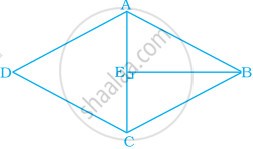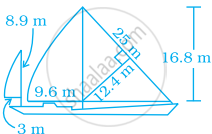Advertisements
Advertisements
प्रश्न
What is the area of the rhombus ABCD below if AC = 6 cm and BE = 4 cm?

विकल्प
36 cm2
16 cm2
24 cm2
13 cm2
उत्तर
24 cm2
Explanation:
The diagonal AC of the rhombus ABCD divides it into two triangles of equal areas.
Now, area of ΔABC = `1/2` × Base × Height
= `1/2 xx 4 xx 6`
= 12 cm2
∴ Area of the rhombus ABCD = 2 × Area of ΔABC
= 2 × 12
= 24 cm2
APPEARS IN
संबंधित प्रश्न
Lengths of the diagonals of a rhombus are 15 cm and 24 cm, find its area.
If perimeter of a rhombus is 100 cm and length of one diagonal is 48 cm, what is the area of the quadrilateral?
The length of the diagonals of a rhombus is in ratio 4 : 3. If its area is 384 cm2, find its side.
Find the area of a rhombus whose diagonals are of lengths 10 cm and 8.2 cm.
Find the missing value.
| Diagonal (d1) | Diagonal (d2) | Area |
| 19 cm | 16 cm |
The angle between the diagonals of a rhombus is
Area of a quadrilateral ABCD is 20 cm2 and perpendiculars on BD from opposite vertices are 1 cm and 1.5 cm. The length of BD is ______.
If the diagonals of a rhombus get doubled, then the area of the rhombus becomes ______ its original area.
The area of a rectangular field is 48 m2 and one of its sides is 6 m. How long will a lady take to cross the field diagonally at the rate of 20 m/minute?
Most of the sailboats have two sails, the jib and the mainsail. Assume that the sails are triangles. Find the total area of sail of the sailboats to the nearest tenth.

